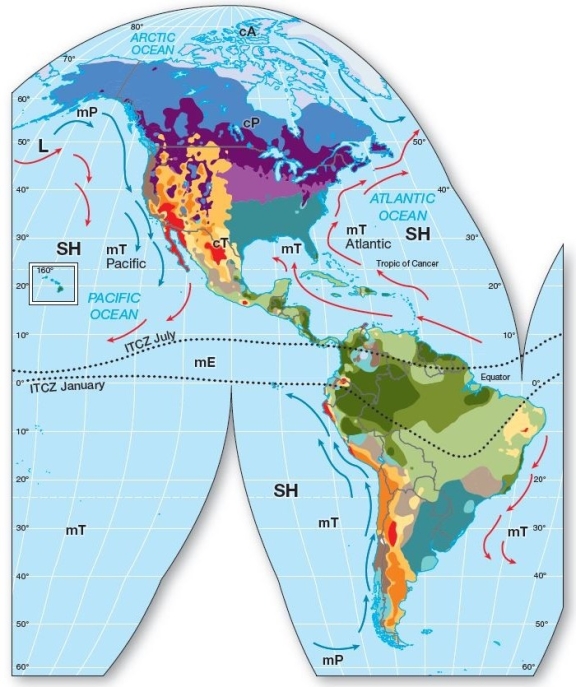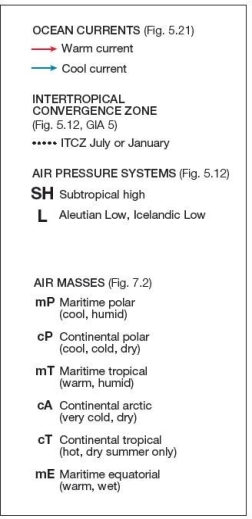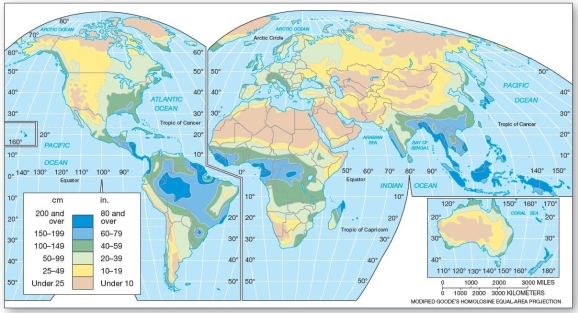A) taiga
B) chaparral
C) rain forest
D) boreal forest
E) selva
G) A) and D)
Correct Answer

verified
B
Correct Answer
verified
Multiple Choice
The two principal climate components are
A) temperature and pressure.
B) temperature and precipitation.
C) precipitation and pressure.
D) pressure and wind speed.
E) wind speed and precipitation
G) B) and D)
Correct Answer

verified
Correct Answer
verified
Multiple Choice

 World climate classification
Which of the following lists the correct,generalized sequence of climates from the equator to the poles?
World climate classification
Which of the following lists the correct,generalized sequence of climates from the equator to the poles?
A) Tropical → Dry → Mesothermal → Microthermal → Highland
B) Tropical → Mesothermal → Dry → Microthermal → Polar
C) Tropical → Dry → Mesothermal → Microthermal → Polar
D) Polar → Microthermal → Dry → Mesothermal → Tropical
E) Dry → Tropical → Mesothermal → Microthermal → Polar
G) A) and E)
Correct Answer

verified
Correct Answer
verified
Multiple Choice
Which climate is characterized by the largest change in monthly average temperatures;i.e. ,the greatest change in temperatures from one month to the next?
A) subarctic cold-winter
B) tundra
C) marine west coast
D) dry-midlatitude
E) Mediterranean
G) A) and E)
Correct Answer

verified
Correct Answer
verified
Multiple Choice
Dry climates are divided into two types according to moisture.These are
A) deserts and steppe.
B) deserts and tundra.
C) steppe and chaparral.
D) chaparral and tundra.
E) chaparral and selva.
G) C) and D)
Correct Answer

verified
Correct Answer
verified
Multiple Choice
____climates occupy the most extensive area of land on Earth.
A) Polar
B) Dry
C) Mesothermal
D) Tropical
E) Microthermal
G) B) and C)
Correct Answer

verified
Correct Answer
verified
Multiple Choice
Which of the following best describes the difference between weather and climate?
A) Weather is the collective pattern of atmospheric conditions in a given region over long periods of time,whereas climate is the atmospheric conditions at a given time and place.
B) Climate is the collective pattern of atmospheric conditions in a given region over long periods of time,whereas climate is the atmospheric conditions at a given time and place.
C) Weather refers specifically to the temperature of a given place at a given time,whereas climate refers to temperature,humidity,pressure,and wind conditions of a given place at a given time.
D) Climate refers specifically to the temperature of a given place at a given time,whereas weather refers to temperature,humidity,pressure,and wind conditions of a given place at a given time.
E) Weather and climate are essentially the same thing.
G) B) and E)
Correct Answer

verified
Correct Answer
verified
Multiple Choice
Which of the following is not an element of weather and climate?
A) insolation
B) temperature
C) atmospheric moisture
D) air pressure
E) hourly winds speed and direction
G) A) and E)
Correct Answer

verified
Correct Answer
verified
Multiple Choice
Which of the following is not true of marine west-coast climates?
A) They are dominated by mP air masses.
B) The air masses in this region are unstable.
C) These climates experience very cold winters due to high latitude (about 45° to 55° north) .
D) Weather systems forming along the polar front and maritime polar air masses move into the region throughout the year.
E) Coastal fog is part of the moderating marine influence.
G) D) and E)
Correct Answer

verified
Correct Answer
verified
Multiple Choice
The western Great Plains of North America are characterized by a _____climate.
A) tropical hot desert
B) subtropical hot desert
C) midlatitude cold desert
D) midlatitude cold steppe
E) subtropical hot steppe
G) A) and D)
Correct Answer

verified
Correct Answer
verified
Multiple Choice
Along the periphery of hot deserts,where shifting subtropical high pressure cells create a distinct summer-dry and winter-wet pattern,one finds
A) tropical,subtropical hot steppe climates.
B) marine west coast climates.
C) tropical monsoon climates.
D) humid subtropical hot-summer climates.
E) Mediterranean climates.
G) None of the above
Correct Answer

verified
Correct Answer
verified
Multiple Choice
Climate is
A) the weather of a region.
B) the short-term condition of the atmosphere.
C) the long-term atmospheric condition-including extremes that may occur.
D) a reference to temperature patterns only.
E) the average precipitation an area receives in a month.
G) A) and B)
Correct Answer

verified
Correct Answer
verified
Multiple Choice
Areas within tundra climates with a strong maritime influence are called ____climates.
A) maritime tundra
B) ice cap
C) highland
D) ice sheet
E) polar marine
G) B) and C)
Correct Answer

verified
E
Correct Answer
verified
Multiple Choice
Which of the following is false regarding the tropical monsoon climate?
A) It is located along coastal areas.
B) The transition from wet to dry conditions is the result of the shifting of the ITCZ.
C) The wind direction shifts from one time of the year to the next.
D) The summer (high Sun season) is the driest time of the year.
E) It occurs in areas with seasonal variations in precipitation.
G) All of the above
Correct Answer

verified
Correct Answer
verified
Multiple Choice
Which of the following is not true of tropical and subtropical hot desert climates?
A) In most years,they do not receive any precipitation.
B) Annual average temperatures are above 18°C (64.4°F) .
C) They are generally found on the western side of continents.
D) They are under the influence of subtropical high pressure systems.
E) In some areas,such as the Sahel,desert conditions are expanding.
G) A) and B)
Correct Answer

verified
Correct Answer
verified
Multiple Choice
Mediterranean dry-summer climates
A) experience dry conditions in summer due to the subtropical high overhead.
B) experience wet conditions in winter due to the ITCZ overhead.
C) are bordered poleward by steppe climates.
D) experience wet conditions in summer due to the ITCZ overhead.
E) experience wet conditions in the summer due to the subtropical high overhead.
G) A) and C)
Correct Answer

verified
Correct Answer
verified
Multiple Choice
Which of the following is incorrect regarding tundra climates?
A) Spruce,fir and larch trees survive in this climate zone.
B) There is no true summer in this region.
C) Summer temperatures are never higher than 10°C (50°F) .
D) The land is under continuous snow cover from 8 to 10 months.
E) Tundra climates occur primarily in the Northern Hemisphere.
G) A) and C)
Correct Answer

verified
Correct Answer
verified
Multiple Choice
Which of the following characterizes a tropical savanna climate?
A) It experiences a summer wet season,and is dominated by the ITCZ for nearly 12 months of the year.
B) The sun's direct rays are overhead (subsolar point) are overhead twice each year.
C) All months receive precipitation in excess of 6 cm (2.4 in. ) .
D) Its annual temperature variability is less than that of the tropical rain forest.
E) It is dominated by the ITCZ for nearly 12 months a year.
G) A) and E)
Correct Answer

verified
Correct Answer
verified
Multiple Choice
 Worldwide average annual precipitation
Regarding average annual precipitation,which of the following is correct?
Worldwide average annual precipitation
Regarding average annual precipitation,which of the following is correct?
A) The highest amounts occur throughout subtropical latitudes.
B) The drier regions are associated with the eastern portions of major landmasses.
C) The precipitation tends to increase with latitude toward the poles.
D) The highest average values occur along the equator.
E) Precipitation values tend to be greatest in central Australia.
G) A) and B)
Correct Answer

verified
D
Correct Answer
verified
Multiple Choice
Global circulation patterns of winds and ocean currents,which drive weather systems and,ultimately,climate patterns are created by
A) the Coriolis force.
B) frictional force caused by the Earth's spinning on its axis.
C) latitudinal energy imbalance between tropical and polar regions.
D) the differential heating properties of land and water.
E) differential cloud cover over Earth's surface.
G) C) and D)
Correct Answer

verified
Correct Answer
verified
Showing 1 - 20 of 77
Related Exams